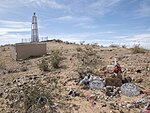Jordkonstverk i öknarna i sydvästra USA


Jordkonstverk i öknarna i sydvästra USA är en väsentlig del av den amerikanska konströrelsen för jordkonst, som uppstod under 1960-talet och framför allt utvecklades av konstnärer i New York.[1] Önskemål av konstnärerna inom jordkonst om att skapa mycket stora konstverk gjorde att intresset riktades mot ökenområdena i sydvästra USA, med en myckenhet tillgängliga och öppna landskap. En av pionjärerna inom området var Robert Smithson, vars verk Spiral Jetty från 1970 i Stora Saltsjön i Utah väckte stor uppmärksamhet för originalitet. Jordkonsten har sedan dess avsatt särskilt många monumentala konstverk i sydvästra USA. Ökenområdena i delstaterna New Mexico, Colorado, Kalifornien och Nevada var särskilt populära. Ett flertal jordkonstverk tillkom där under 1970-talet. Några av dessa verk är av sådan storleksordning, att de inte färdigställts på decennier: Rodenkratern[2] (påbörjat 1979), City[3] (påbörjat 1972) och Star Axis[4] (påbörjat 1976).
Jordkonstverk i sydvästra USA i urval
- Spiral Jetty av Robert Smithson i Stora Saltsjön i Utah, 1970 41°26′16″N 112°40′8″V / 41.43778°N 112.66889°V
- The Lightning Field av Walter De Maria i Catron County i New Mexico från 1977 34°31′0.14″N 108°6′20.95″V / 34.5167056°N 108.1058194°V
- Rodenkratern av James Turrell, nordost om Flagstaff i Colorado, från 1976 35°25′32″N 111°15′31″V / 35.42556°N 111.25861°V
- Desert Lighthouse av Daniel Hawkins i Mojaveöknen i Kalifornien från 2017 34°57′27.0″N 117°12′45.7″V / 34.957500°N 117.212694°V
- Double Negative av Michael Heizer i Moapa Valley i Nevada från 1969 36°36′57″N 114°20′40″V / 36.61586°N 114.34455°V
- Sun Tunnels av Nancy Holt utanför spökstaden Lucin i Utah från 2018 41°18′13″N 113°51′50″V / 41.303501°N 113.863831°V
- Star Axis av Charles Ross öster om Las Vegas, New Mexico i New Mexico (påbörjat 1976) 35°15′51″N 105°05′14″V / 35.26417°N 105.08722°V
- City av Michael Heizer i Lincoln County i Nevada (påbörjat 1972) 38°01′48″N 115°26′10″V / 38.03000°N 115.43611°V
Bildgalleri
Desert Lighthouse av Daniel Hawkins
Utah monolith
Se även
- Chinati Foundation, en konstutställning på ett 1,4 kvadratkilometer stort område i en tidigare militärbas, som började byggas upp av Donald Judd i Marfa i Texas från 1977 30°17′55″N 104°01′37″V / 30.298722°N 104.027009°V
- Utah monolith av okänd konstnär nära Moab i Utah från 2015–2016 38°20′35.2″N 109°39′58.5″V / 38.343111°N 109.666250°V
Källor
Noter
- ^ Earth Art på The Art Story
- ^ Rodenkraterns webbplats
- ^ A monument to outlast humanity i New Yorker den 29 augusti 2016
- ^ Nancy Hass: A Land Art Pioneer’s Adventures in Time and Space – Nearly 50 years after Charles Ross began working on “Star Axis,” the artist’s gargantuan work in the New Mexico desert is nearing completion. i New York Times den 21 juli 2020
Externa länkar
| |||||||||||||
Media som används på denna webbplats
Författare/Upphovsman: BuckBurns, Licens: CC BY-SA 4.0
In the foreground memorials are visible at the Desert Lighthouse. April 2019.
Författare/Upphovsman: Boberger. Photo: Bengt Oberger, Licens: CC BY 3.0
Maya Lin´s 11 Minute Line, Wanås Castle, Sweden
Författare/Upphovsman: Retis, Licens: CC BY 2.0
Lucin, Utah
Nancy Holt is most widely known for her large-scale artwork Sun Tunnels (located in Lucin, UT); however, she has created works in public places all over the world. The artist's interest in light, perspective, time, and space certainly influenced her photographs, films, sculpture, and installation art, but perhaps it is most magnificently illustrated in her Land art. Land art emerged in the 1960s, coinciding with a growing ecology movement in the United States, which asked people to become more aware of the impact they can have on the natural environment. Land art changed the way people thought of art; not only did it take art out of the gallery and museum, but it also took art out of the market. Many Land art sites are located in remote, uninhabited regions. We are lucky that such an influential work of art is within a day's drive from the UMFA.
Sun Tunnels consists of four massive concrete tunnels, each eighteen feet long and nine feet in diameter, laid out in the desert in an open X configuration. On the solstices, the tunnels frame the sun as it passes the horizon at sunrise and sunset. In the top of each tunnel, Holt drilled small holes to form the constellations of Draco, Perseus, Columba, and Capricorn. These holes, and the tunnels themselves, act as frames or lenses through which the visitor can view the surrounding sky and landscape of the Great Basin Desert.
To create her 1978 film Sun Tunnels, Holt camped for days on end in the barren desert. In Holt's cinematic and photographic documents currently on view at the Utah Museum of Fine Arts, we can observe myriad nuances of light and shadow inhabiting the installation over time. But to fully experience this important work of Land art, climb into the tunnels, view the surrounding landscape through the cylindrical frames, and feel the desert air in Utah's Great Basin.
umfa.utah.edu/suntunnels_selfguide(c) Clf23 på engelska Wikipedia, CC BY 2.5
"Double Negative", land art by Michael Heizer
Författare/Upphovsman: Patrickamackie2 (Patrick A. Mackie), Licens: CC BY-SA 4.0
The Utah Monolith.
Spiral Jetty from atop Rozel Point, in mid-April 2005.











